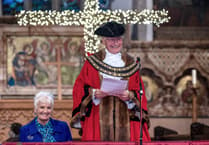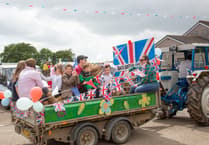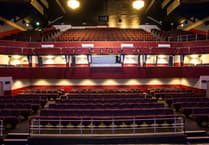Charlestown’s Crinnis Cliff Battery was constructed in 1793 by Charles Rashleigh, to protect his busy port, exporting tin and china clay and importing the coal necessary to power local industries.
In recent years, volunteers have worked hard to clear the battery, and on Saturday St Piran’s flag was raised to great fanfare on the shiny new flagpole, the first on the site for over 100 years.
Around 60 people were there to toast the flagpole, St Piran on his special weekend – and Charles Rashleigh in the bicentennial year of his death.
This was the first of several special events to commemorate the life of Charlestown’s founding father; Andy Trudgian, president of Charlestown History Group, hopes it will present him in a new and more favourable light.
Rashleigh was born in 1747, into a family that produced MPs, high sheriffs, major land-owners and geologists. The family seat at Menabilly was later immortalised in Daphne du Maurier’s Rebecca.
Charles was an entrepreneur, and bought the coastal hamlet of West Polmear, transforming it into the port that took his name. But by the time he died, on March 9, 1823, he was penniless. “From what we can gather, he was a man of generous spirit, but he was betrayed by those he tried to help, and died bankrupt,” says Andy.
“His part of the family lost Charlestown in lieu of debt, and history has tended to focus on that side of his life.
“We feel we should look earlier for his legacy: the building of Charlestown and the industrialisation of mid-Cornwall. Today, we have an unspoiled Georgian port, and arguably St Austell would not have developed the way it has without it.”
Charlestown History Group steering committee member Peter Hancock says the port’s founder is largely forgotten.
Rashleigh was buried in St Austell, but like many others, his gravestone was moved to High Cross Cemetery, meaning there is nothing to remember him by in Holy Trinity Church.
The prospect of a commemorative plaque is under discussion with St Austell Old Cornwall Society.
The earliest image of the site from 1800 shows a flagpole in place, presumably erected by Rashleigh himself in the 1790s.
The new flagpole was hand-crafted by a Charlestown shipwright, and the first raising of the St Piran flag took place on Saturday.
The battery is one of the few remaining in Cornwall from the Napoleonic era, with many having succumbed to the natural elements or been manually dismantled.
The site also served as a lookout and signalling station during the Second World War.
But in latter years, it had fallen into disrepair.
During the pandemic, history group members carried out a significant amount of work to reveal historic features such as the powder magazine and the equipment shed foundation, the platforms on which the guns stood and the centuries-old flagpole ground anchors.
The honour of raising the first flag fell to local landowner Peter Browning, whose family offered financial support and have been trustees of the battery for over 30 years, having just sealed their third licence for public access from Cornwall Council.
He said: “Last year, Andy and his team took on the heroic task of the battery’s second restoration. They did a magnificent job and deserve the widest recognition for their efforts. It’s a proper job for Cornwall.”
Future events include a collaboration with St Austell Players on a promenade performance depicting major achievements in Rashleigh’s life at key locations around Charlestown.
The site will become a valuable educational resource, and the history group hopes to invest in interpretation boards and buy a cannon to place on one of the original bases.
The flag will be raised on significant days, and locals are invited to make a donation for their own special events.
Visit the website for availability and information on how to donate: www.charlestownhistorygroup.com/flag





Comments
This article has no comments yet. Be the first to leave a comment.